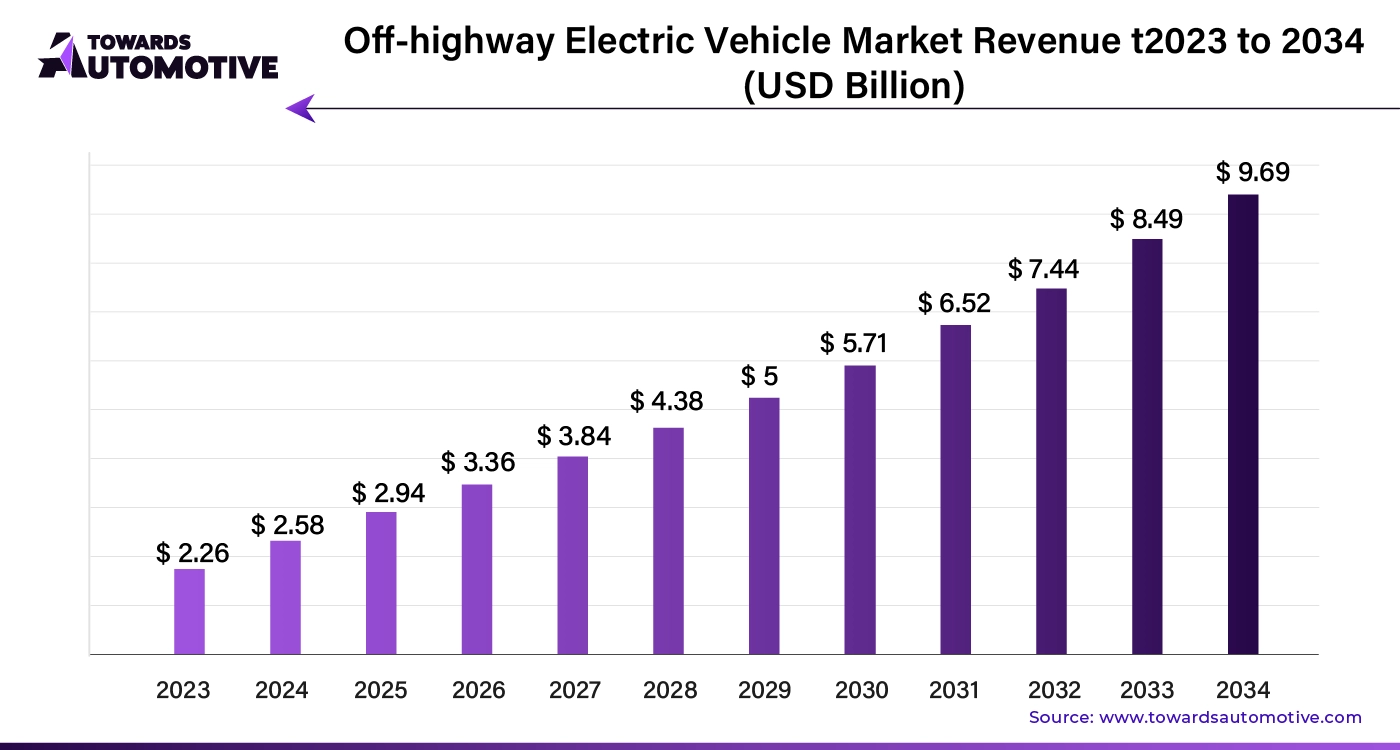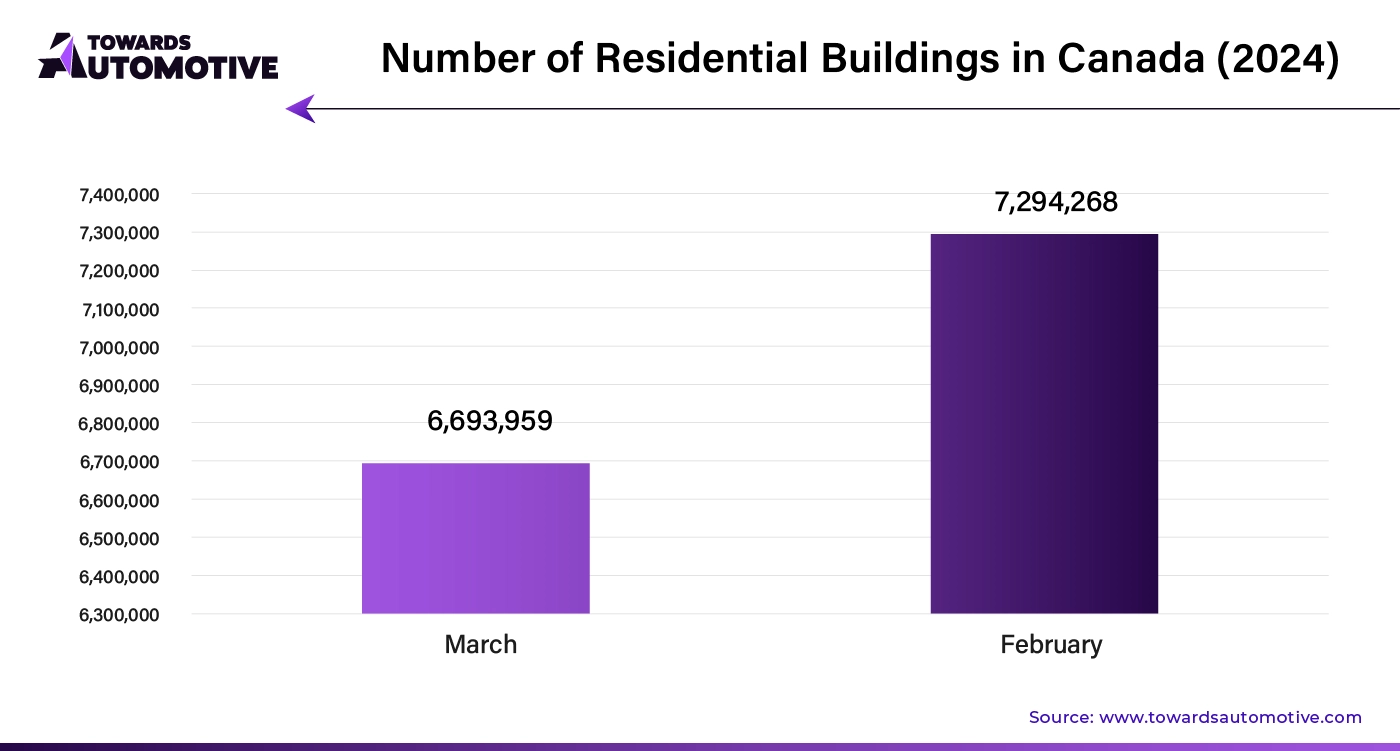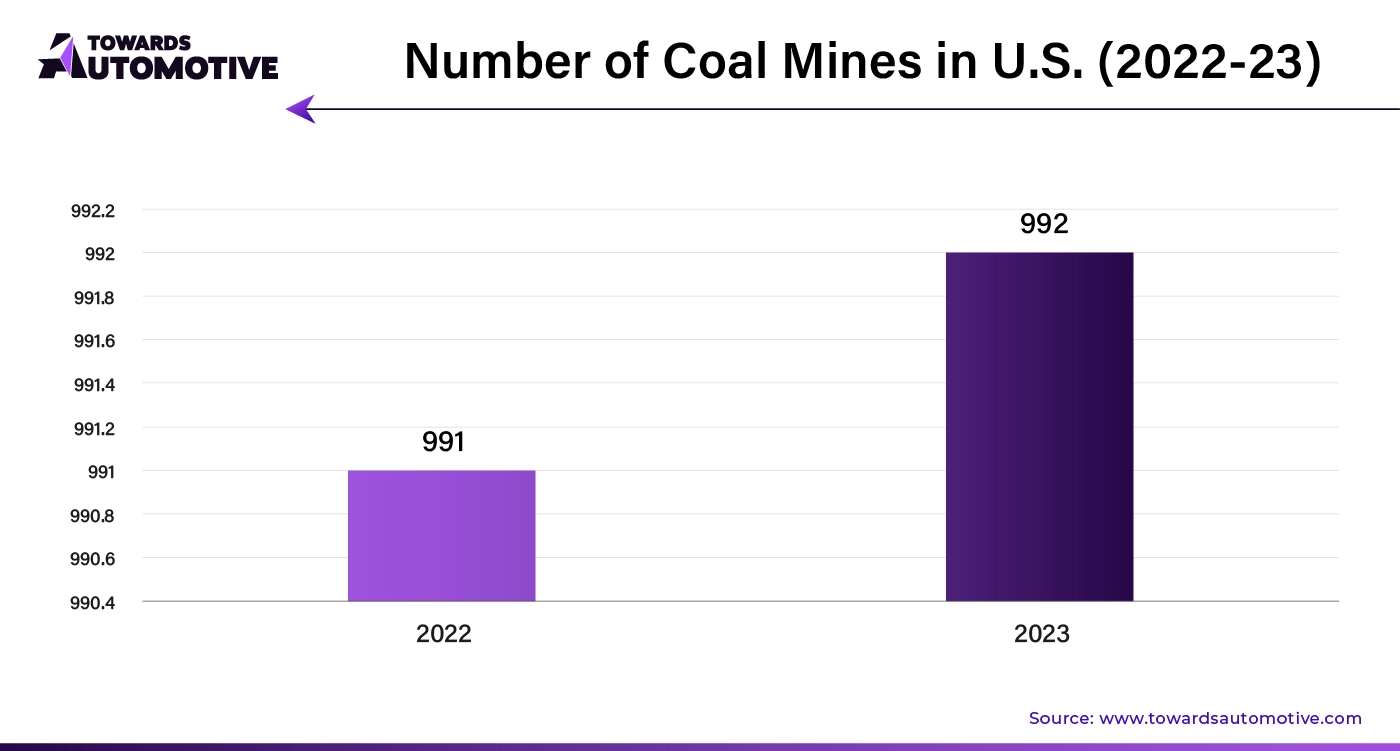April 2025
The global off-highway electric vehicle market size is calculated at USD 2.58 billion in 2024 and is expected to be worth USD 9.69 billion by 2034, expanding at a CAGR of 14.15% from 2024 to 2034.

Unlock Infinite Advantages: Subscribe to Annual Membership
The off-highway electric vehicle market is experiencing rapid growth as industries such as construction, mining, agriculture, and forestry increasingly prioritize sustainability and operational efficiency. Off-highway electric vehicles, including electric excavators, loaders, and tractors, offer significant environmental benefits by reducing carbon emissions, noise pollution, and fuel dependency. With growing global awareness of environmental concerns and stringent emissions regulations, companies are transitioning from traditional diesel-powered machines to electric alternatives, which provide both environmental and cost-saving advantages.
Technological advancements, particularly in battery efficiency and electric drivetrains, are driving the adoption of OHEVs. Innovations in lithium-ion and solid-state batteries are enabling longer operational ranges and faster charging times, making electric vehicles more suitable for demanding off-road applications. The reduction in operating costs, due to lower fuel consumption and reduced maintenance needs, is another key driver encouraging the shift to electric-powered equipment.
Government initiatives promoting clean energy, alongside incentives and subsidies for electric vehicle adoption, are further accelerating market growth. Additionally, the integration of smart technologies like AI-driven automation and advanced telematics is enhancing the performance and efficiency of off-highway electric vehicles, making them even more attractive to industries focused on productivity and sustainability.
As infrastructure for electric vehicles expands and more manufacturers enter the market with innovative electric solutions, the Off-highway Electric Vehicle market is poised for substantial growth, shaping the future of sustainable industrial operations across multiple sectors.
AI plays a transformative role in the off-highway electric vehicle market by enhancing vehicle efficiency, safety, and operational performance. One of the key contributions of AI is in the development of autonomous and semi-autonomous electric vehicles, which are increasingly being deployed in sectors like mining, agriculture, and construction. AI-powered vehicles can navigate complex terrains, perform tasks like loading, excavation, or harvesting with minimal human intervention, and optimize operations through real-time data analysis.
AI also contributes to predictive maintenance, a critical aspect for off-highway vehicles that often operate in harsh conditions. By analyzing sensor data, AI can detect potential issues before they lead to costly breakdowns, ensuring that electric vehicles remain operational with minimal downtime. This not only extends the lifespan of the vehicles but also reduces maintenance costs and increases productivity.
In addition, AI-driven fleet management systems allow operators to monitor vehicle performance, energy consumption, and battery health remotely. These systems optimize energy usage by adjusting power delivery based on workload, terrain, and other conditions, which improves the range and efficiency of electric vehicles. AI also supports energy management, ensuring optimal battery performance and charging schedules.
AI's integration into OHEVs is also paving the way for advancements in safety, with features like collision avoidance, obstacle detection, and improved navigation systems, further enhancing the market’s appeal. By enabling smarter, more efficient, and autonomous electric vehicles, AI is a key factor driving the growth and evolution of the Off-highway Electric Vehicle market.
The demand for sustainable and eco-friendly mobility solutions is a major driver of growth in the Off-highway Electric Vehicle (OHEV) market. As industries such as construction, mining, agriculture, and forestry face increasing pressure to reduce their environmental impact, companies are turning to electric vehicles to meet stricter emissions regulations and sustainability goals. Off-highway electric vehicles offer zero emissions, quieter operations, and reduced fuel consumption, making them an attractive alternative to traditional diesel-powered machinery.
Governments around the world are implementing policies and incentives to encourage the adoption of electric vehicles in industrial sectors. These regulations, combined with growing consumer and corporate focus on sustainability, are accelerating the shift towards electric solutions in off-highway applications. Additionally, advancements in battery technology, such as improved range and faster charging capabilities, are making electric vehicles more viable for demanding operations in harsh environments.
The reduction in operational costs is another key factor driving the growth of the OHEV market. Electric vehicles have lower maintenance and fuel costs compared to their conventional counterparts, offering long-term savings for businesses. Furthermore, the integration of smart technologies like AI-driven automation and real-time data analytics is enhancing the efficiency and performance of off-highway electric vehicles, making them more appealing for industries focused on productivity and environmental responsibility.
As sustainability becomes a central priority across industries, the demand for eco-friendly mobility solutions is poised to propel the growth of the Off-highway Electric Vehicle market, shaping a cleaner, more efficient future for industrial operations.
The Off-highway Electric Vehicle (OHEV) market faces key restraints, including high upfront costs due to expensive batteries, which deter widespread adoption. Limited charging infrastructure in remote areas and concerns about battery performance in harsh conditions further hinder growth. Additionally, industries used to diesel-powered machinery are hesitant to adopt new technology, particularly when skilled technicians for electric vehicle maintenance are in short supply, slowing the market’s expansion.
Autonomous technologies are unlocking new opportunities in the Off-highway Electric Vehicle market by transforming how industries like mining, construction, and agriculture operate. Self-driving electric vehicles equipped with AI and advanced sensors can perform complex tasks, such as excavation, hauling, and crop harvesting, with minimal human intervention. This automation reduces the need for manual labor in hazardous or remote environments, enhancing safety while lowering operational costs.
Autonomous OHEVs can work continuously, optimizing productivity and efficiency by making real-time decisions based on data inputs, such as terrain conditions or equipment load. This precision reduces errors and increases the reliability of operations, making electric vehicles more appealing to businesses looking for long-term sustainability and cost savings. Additionally, AI-driven fleet management systems help monitor and coordinate multiple vehicles, improving the overall efficiency of industrial projects.
As companies increasingly adopt automation to boost productivity and reduce environmental impact, autonomous technologies are driving the widespread adoption of electric vehicles, creating a growing market for OHEVs in various industries.
The hybrid electric vehicle segment dominated the market. The hybrid electric segment is driving the growth of the Off-highway Electric Vehicle market by offering a balance between traditional fuel efficiency and the benefits of electrification. Hybrid electric vehicles combine internal combustion engines with electric power, providing longer operational ranges and reducing fuel consumption. This makes them ideal for industries like construction, mining, and agriculture, where vehicles need to operate in remote areas without access to charging infrastructure.
Hybrid OHEVs allow companies to reduce emissions and fuel costs while maintaining the power and performance needed for heavy-duty tasks. They also provide flexibility, as they can switch between electric and fuel modes depending on operational demands. This dual functionality makes hybrids more attractive to businesses that are transitioning to fully electric vehicles but still require the reliability of traditional fuel systems for extended operations.
Additionally, hybrid technologies reduce maintenance costs by decreasing wear on internal combustion components, further enhancing their appeal. The growth of the hybrid electric segment is a stepping stone toward fully electric off-highway vehicles, contributing to the market’s overall expansion.
The construction segment held the largest share of the market. The construction segment is a key driver of growth in the Off-highway Electric Vehicle market, as companies seek sustainable and efficient alternatives to traditional diesel-powered machinery. Electric construction vehicles, such as electric excavators, loaders, and bulldozers, offer significant advantages in reducing emissions and lowering operational costs. These vehicles help construction firms meet increasingly stringent environmental regulations while also benefiting from reduced fuel consumption and maintenance expenses.
The shift toward electric vehicles in construction is also driven by their ability to operate quietly, making them ideal for urban projects where noise restrictions are in place. Additionally, advancements in battery technology have improved the performance and range of electric vehicles, making them more capable of handling heavy-duty tasks on construction sites.
Government incentives and regulations promoting green construction practices further encourage the adoption of electric vehicles in this sector. As more construction companies integrate electric vehicles into their fleets to meet sustainability goals and reduce costs, the construction segment continues to drive the expansion of the off-highway electric vehicle market.

According to the Statistics Canada, the number of residential buildings in Canada was 7,294,268 in February 2024 and 6,693,959 in March 2024.
North America dominated the off-highway electric vehicle market during the forecast period. In North America, the Off-highway Electric Vehicle (OHEV) market is driven by strong environmental regulations and the growing emphasis on sustainability across industries. Governments at both federal and state levels are pushing for stricter emissions standards, encouraging industries such as construction, mining, and agriculture to adopt electric alternatives. Financial incentives, such as tax credits and grants, further support the shift to electric vehicles by offsetting the initial high costs of OHEVs.
Technological advancements in battery performance and charging infrastructure are also boosting the market. North America is seeing rapid improvements in battery range and efficiency, making electric vehicles more practical for off-highway applications. Additionally, expanding charging networks, particularly in remote and industrial areas, is reducing concerns over vehicle range and downtime.
The region's focus on reducing fuel dependency and operational costs is another important driver. Electric vehicles offer lower fuel and maintenance costs, which appeal to businesses looking for long-term savings. These factors are collectively driving the growth of the OHEV market in North America.

According to the stats of U.S. Coal Industry, there were 991 coal mines in U.S. in 2022 and the number increased to 992 mines in 2023.
Asia Pacific is projected to grow with the highest CAGR during the forecast period. In the Asia Pacific region, several key drivers are fueling the growth of the Off-highway Electric Vehicle market. Rapid industrialization and urbanization are increasing the demand for heavy-duty machinery in construction, mining, and agriculture. As countries in the region face growing environmental challenges, there is a strong push for cleaner and more sustainable solutions, driving the shift toward electric vehicles.
Government initiatives and regulations are significant motivators, with many countries implementing stricter emissions standards and offering financial incentives for electric vehicle adoption. These policies help offset the initial costs of OHEVs and encourage companies to invest in greener technologies.
Technological advancements in battery efficiency and charging infrastructure are also crucial. Improvements in battery life and the expansion of charging networks, even in remote areas, are making electric vehicles more practical for off-highway applications. Additionally, the region's focus on reducing fuel dependency and lowering operational costs is enhancing the attractiveness of electric vehicles. This, in turn boosts the Off-highway Electric Vehicle market in a positive way.
By Vehicle Type
By Energy Storage Capacity
By Battery Type
By Application
By Region
April 2025
April 2025
April 2025
April 2025
Dr. Arjun Patel is a distinguished expert in the automotive industry, holding advanced degrees in Automotive Engineering and Mechanical Engineering. His expertise spans automotive market dynamics, technological advancements, and sustainable practices. Dr. Patel excels in conducting in depth research and analysis on market trends, consumer preferences, and the economic implications within the automotive sector. He is renowned for his insightful publications on topics such as electric vehicles, autonomous driving technologies, and the evolution of sustainable transportation solutions. Dr. Patels research contributions have significantly advanced understanding in the field, earning him recognition as a leading authority in automotive research and analysis.
We offer automotive expertise for market projections and customizable research, adaptable to diverse strategic approaches.
Contact Us